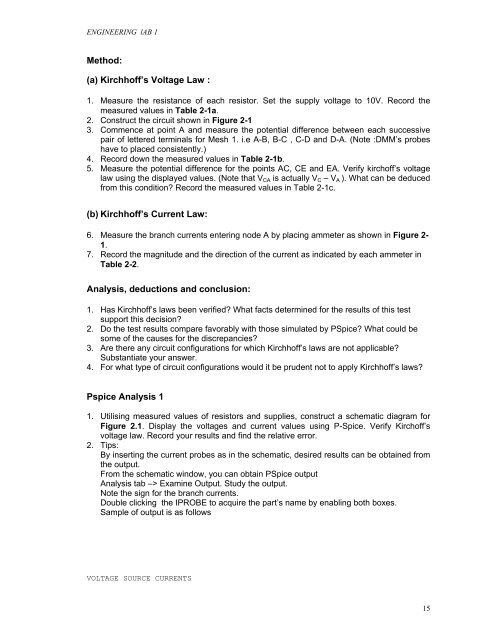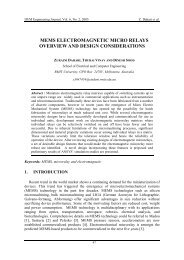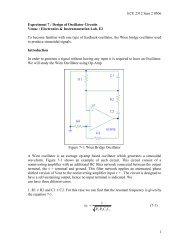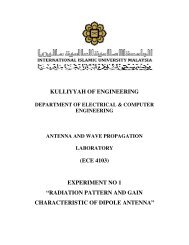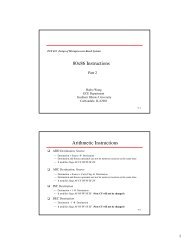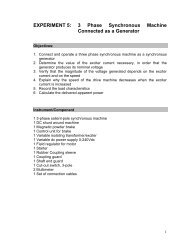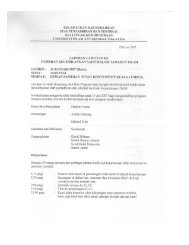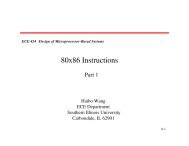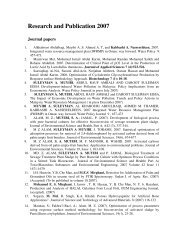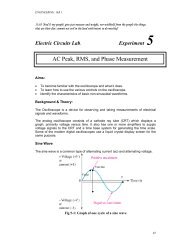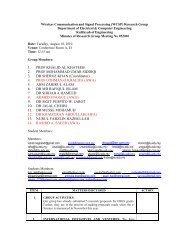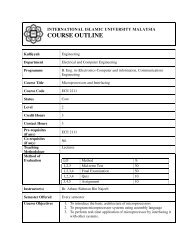Kirchoff's Voltage and Current Laws
Kirchoff's Voltage and Current Laws
Kirchoff's Voltage and Current Laws
You also want an ePaper? Increase the reach of your titles
YUMPU automatically turns print PDFs into web optimized ePapers that Google loves.
ENGINEERING lAB 1Method:(a) Kirchhoff’s <strong>Voltage</strong> Law :1. Measure the resistance of each resistor. Set the supply voltage to 10V. Record themeasured values in Table 2-1a.2. Construct the circuit shown in Figure 2-13. Commence at point A <strong>and</strong> measure the potential difference between each successivepair of lettered terminals for Mesh 1. i.e A-B, B-C , C-D <strong>and</strong> D-A. (Note :DMM’s probeshave to placed consistently.)4. Record down the measured values in Table 2-1b.5. Measure the potential difference for the points AC, CE <strong>and</strong> EA. Verify kirchoff’s voltagelaw using the displayed values. (Note that V CA is actually V C – V A ). What can be deducedfrom this condition? Record the measured values in Table 2-1c.(b) Kirchhoff’s <strong>Current</strong> Law:6. Measure the branch currents entering node A by placing ammeter as shown in Figure 2-1.7. Record the magnitude <strong>and</strong> the direction of the current as indicated by each ammeter inTable 2-2.Analysis, deductions <strong>and</strong> conclusion:1. Has Kirchhoff’s laws been verified? What facts determined for the results of this testsupport this decision?2. Do the test results compare favorably with those simulated by PSpice? What could besome of the causes for the discrepancies?3. Are there any circuit configurations for which Kirchhoff’s laws are not applicable?Substantiate your answer.4. For what type of circuit configurations would it be prudent not to apply Kirchhoff’s laws?Pspice Analysis 11. Utilising measured values of resistors <strong>and</strong> supplies, construct a schematic diagram forFigure 2.1. Display the voltages <strong>and</strong> current values using P-Spice. Verify Kirchoff’svoltage law. Record your results <strong>and</strong> find the relative error.2. Tips:By inserting the current probes as in the schematic, desired results can be obtained fromthe output.From the schematic window, you can obtain PSpice outputAnalysis tab –> Examine Output. Study the output.Note the sign for the branch currents.Double clicking the IPROBE to acquire the part’s name by enabling both boxes.Sample of output is as followsVOLTAGE SOURCE CURRENTS15


